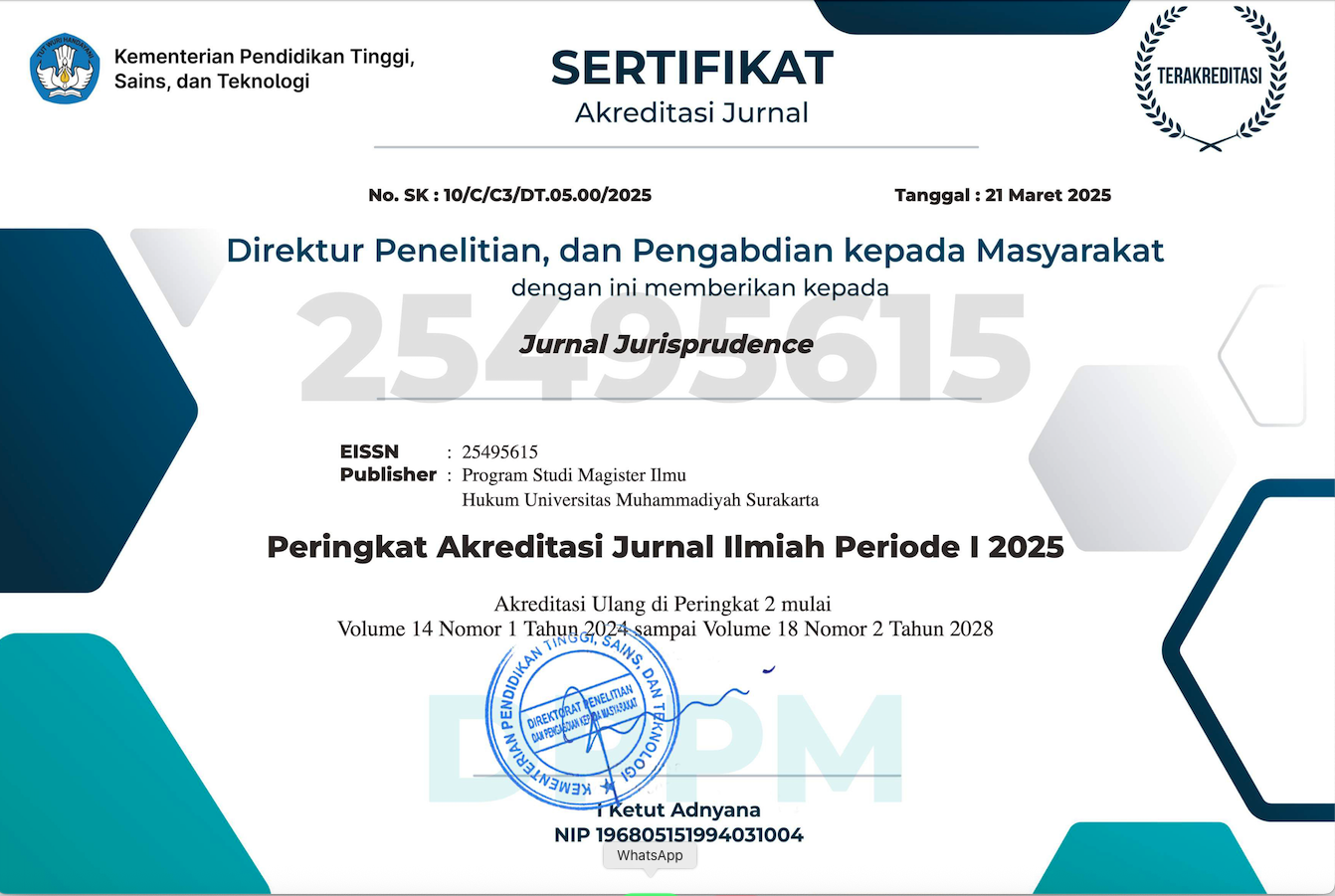Judicial Restraint Law Judicial Restraint Law Politics of the Constitutional Court Against Parliamentary Threshold: A Comparison of Indonesia and Philippines
DOI:
https://doi.org/10.23917/jurisprudence.v15i1.8716Keywords:
Keywords: judicial restraint, Constitutional Court, Parliamentary ThresholdAbstract
ABSTRACT
The Purpose of this Research is to examine 1) Legal construction of the Judicial Review of Parliamentary Threshold No. 44/PUUXV/2017 and No. 62/PUU-XXII/2024 on Judicial Restraint of Constitutional Court Judges in Indonesia and 2) Legal politics of the regulation and application of parliamentary thresholds in the Philippines.
The Research Method was a literature review in the form of normative research, which employed the qualitative method. The research approach was in the form of legislation using the statute approach, namely Constitutional Court Decisions No. 44/PUUXV/2017 and No. 62/PUU-XXII/2024 on Parliamentary Thresholds. It applied the comparative approach by comparing the parliamentary thresholds of Indonesia and the Philippines. Then, it also employed the conceptual approach, namely the theory of legal politics, the theory of judicial restraint, and the theory of the independence of the judiciary and analytical tools.
The Results of the Research found: 1). Legal political construction of the Judicial Review of Parliamentary Threshold No. 44/PUUXV/2017 and No. 62/PUU-XXII/2024 on the Judicial Restraint Judge of the Constitutional Court of the Republic of Indonesia, namely: Constitutional limitation, policy limitation, doctrine limitation, and simplifying the multi-party system through the simplification of political parties, i.e., reducing the number of political parties. 2) Concerning the legal politics on the regulation and implementation of parliamentary threshold regulations in the Philippines, this country does not have a Constitutional Court. Thus, one cannot file a judicial review of election laws in the Philippines. Therefore, the Philippines is only subject to and obeys the regulations of the Philippine Constitution, which regulates the parliamentary threshold. Meanwhile, the implementation of the Philippine parliamentary threshold refers to the rules of the 1987 Constitution of the Republic of the Philippines, which applies a parliamentary threshold of 20%, by dividing the total list of voters to obtain one seat in parliament.
Study Application: In Judicial Restraint Law Politics of the Constitutional Court Against Parliamentary Threshold: Through Decision No. 62/PUU-XXII/2024, the Indonesian government carried out an open legal policy on the presidential threshold provision to remove the parliamentary threshold. The Constitutional Court judge argued that there was an imbalance between the older (larger) political parties and the newer (smaller) political parties. Thus, small parties could be allowed to nominate presidential candidates, which follows the principle of equality in democracy guaranteed by the 1945 Constitution. Meanwhile, in the Philippines, the judicial restraint law politics of the constitutional court against parliamentary threshold refers to the 1987 Constitution of the Republic of the Philippines, which is 20%.
Usefulness of Research: First, academically, it is hoped that this research can become a reference for future research regarding the judicial restraint law of the constitutional court against bthe parliamentary threshold, a comparison between Indonesia and the Philippines. Second, practically, in the judicial restraint, the threshold of the Indonesian parliament, judges can provide considerations in making decisions without intervention from any party, so that they can uphold the dignity of Constitutional Court Judges and create just decisions. Then, the application of the Philippine parliamentary threshold must comply with the rules of the 1987 Constitution of the Republic of the Philippines.
Keywords: Judicial Restraint, Constitutional Court, Parliamentary Threshold.
ABSTRAK
Tujuan penelitian ini adalah untuk mengkaji 1) Konstruksi hukum Judicial Review terhadap Parliamentary Threshold No. 44/PUUXV/2017 dan No. 62/PUU-XXII/2024 tentang Judicial Restraint Hakim Mahkamah Konstitusi di Indonesia dan 2) Politik hukum pengaturan dan penerapan ambang batas parlemen di Filipina.
Metode penelitian yang digunakan adalah kajian pustaka berupa penelitian normatif dengan metode kualitatif. Pendekatan penelitian berupa legislasi dengan menggunakan pendekatan perundang-undangan, yaitu Putusan Mahkamah Konstitusi No. 44/PUUXV/2017 dan No. 62/PUU-XXII/2024 tentang Parliamentary Threshold. Penelitian ini menggunakan pendekatan komparatif dengan membandingkan ambang batas parlemen Indonesia dan Filipina. Kemudian, penelitian ini juga menggunakan pendekatan konseptual, yaitu teori politik hukum, teori judicial restraint, serta teori independensi peradilan dan perangkat analisisnya. Hasil Penelitian menemukan: 1). Konstruksi politik hukum Perkara Judicial Review Parliamentary Threshold No. 44/PUUXV/2017 dan No. 62/PUU-XXII/2024 tentang Kekangan Hakim Mahkamah Konstitusi Republik Indonesia, yaitu: pembatasan konstitusional, pembatasan kebijakan, pembatasan doktrin, dan penyederhanaan sistem multipartai melalui penyederhanaan partai politik, yaitu pengurangan jumlah partai politik. 2) Mengenai politik hukum pengaturan dan pelaksanaan ketentuan ambang batas parlemen di Filipina, negara ini tidak memiliki Mahkamah Konstitusi. Dengan demikian, seseorang tidak dapat mengajukan uji materi undang-undang pemilu di Filipina. Oleh karena itu, Filipina hanya tunduk dan patuh pada ketentuan Konstitusi Filipina, yang mengatur ambang batas parlemen. Sementara itu, penerapan ambang batas parlemen Filipina mengacu pada aturan Konstitusi Republik Filipina tahun 1987, yang menerapkan ambang batas parlemen sebesar 20%, dengan membagi seluruh daftar pemilih untuk memperoleh satu kursi di parlemen.
Aplikasi Studi: Dalam Politik Hukum Pembatasan Yudisial Mahkamah Konstitusi terhadap Ambang Batas Parlemen: Melalui Putusan No. 62/PUU-XXII/2024, pemerintah Indonesia menjalankan kebijakan hukum terbuka mengenai ketentuan ambang batas presidensial untuk menghapus ambang batas parlemen. Hakim Mahkamah Konstitusi berpendapat bahwa terdapat ketidakseimbangan antara partai politik yang lebih tua (lebih besar) dan partai politik yang lebih baru (lebih kecil). Dengan demikian, partai-partai kecil dapat diizinkan untuk mengajukan calon presiden, yang mengikuti prinsip kesetaraan dalam demokrasi yang dijamin oleh Konstitusi 1945. Sementara itu, di Filipina, politik hukum pembatasan yudisial Mahkamah Konstitusi terhadap ambang batas parlemen mengacu pada Konstitusi Republik Filipina tahun 1987, yaitu sebesar 20%.
Kegunaan Penelitian: Pertama, secara akademis, penelitian ini diharapkan dapat menjadi referensi bagi penelitian selanjutnya mengenai hukum pembatasan kekuasaan kehakiman Mahkamah Konstitusi terhadap ambang batas parlemen, perbandingan antara Indonesia dan Filipina. Kedua, secara praktis, dalam pembatasan kekuasaan kehakiman, ambang batas parlemen Indonesia, hakim dapat memberikan pertimbangan dalam mengambil keputusan tanpa intervensi dari pihak mana pun, sehingga dapat menjunjung tinggi martabat Hakim Mahkamah Konstitusi dan menciptakan putusan yang adil. Selanjutnya, penerapan ambang batas parlemen Filipina harus sesuai dengan aturan Konstitusi Republik Filipina tahun 1987.
Kata Kunci: Pembatasan Kehakiman, Mahkamah Konstitusi, Ambang Batas Parlemen
Submitted
Accepted
Published
Issue
Section
License
Copyright (c) 2025 Jurnal Jurisprudence

This work is licensed under a Creative Commons Attribution 4.0 International License.
















